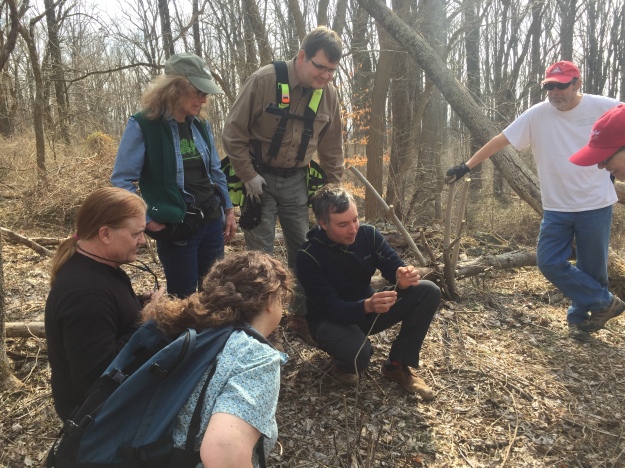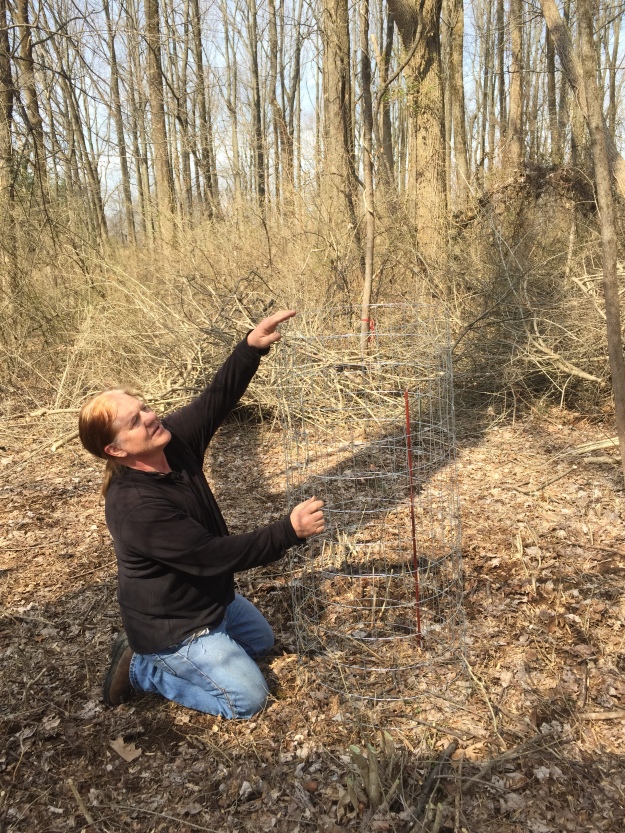
Saving Saplings – A Sourland Steward Workshop: volunteers learned about the complexity of the ecosystem around us and how we, as Land Stewards, can effect positive change for the organisms around us – pollinators, birds, amphibians and other animals – including humans!
The Sourland Conservancy’s Naturalist Advisor, Jared Rosenbaum, has been training volunteers to identify plants and learn practical skills of habitat restoration in order to effect positive change on our ecosystem. On March 30th, Jared led a group of Sourland Stewardship Leaders and volunteers on a hike to a restoration area on Baldpate Mountain where the Sourland Conservancy and Mercer County Park Commission have been working to restore the native plant community. This restoration and education project has been funded in part by the Nature Conservancy. Two important aspects of the habitat restoration are removal of invasive plant species that are out-competing native plants and protecting native plants from deer herbivory.
Our group spent the first portion of our morning hike learning how to identify plants during a very tricky time of year – early spring! During the winter, buds are dormant and look fairly consistent between individuals of the same species. However, in the early spring these buds start to swell and open to reveal flowers and leaves and can look very different than their former selves – sort of like our awkward teenage phase… So when working out what a plant may or may not be, you may need to use many senses to help you figure out how to identify the plant. Sight, touch, smell and yes, taste! Be forewarned, you do not want to go sticking any plant in your mouth unless you are sure it is not toxic!
After our plant identification refresher, we learned how to build individual deer fencing around native trees and shrubs to allow them to grow past the browse line of deer. I learned that spicebush, Lindera benzoin, is an important nesting plant for neo-tropical birds. Unfortunately, deer herbivory can cause the shrub to not have the same growth habit (it would end up growing sparsely and in weird angles) and thus would not provide suitable nesting habitat. Another plant, blackhaw, Viburnum prunifolium, is an important food source to fuel migration in the fall. Without protection from deer browse, blakhaw will not grow large enough to produce flowers and fruits.
 This group of volunteers was ready to work hard to Save the Sourlands!
This group of volunteers was ready to work hard to Save the Sourlands!

Jared introduced the restoration project and explained what has been done so far in this area.

Jared going over basic plant anatomy and then giving key characteristics of spicebush, Lindera benzoin. It can be tricky to identify spicebush in the winter. Even without the leaves, you can still smell the plant by scratching away some bark with your fingernail and then taking a whiff.

Spicebush, Lindera benzoin, flower bud that is just about to burst!
 Jared described how to identify the different hickory (Carya spp.) species.
Jared described how to identify the different hickory (Carya spp.) species.

Here is a young hickory sapling, Carya spp.. This is one of the target species we were working to protect.

Sourland Conservancy Board member and Stewardship Committee Chair, Chris Berry, described how to identify blackhaw viburnum, Viburnum prunifolium.

Jared pointed out key characteristics of bitternut hickory, Carya cordiformis.

Bitternut hickory (Carya cordiformis) is easy to distinguish from the other native hickories because of its sulphur-yellow buds.

These large “Monkey face” leaf scars belong to black walnut, Juglans nigra. Walnuts and hickories belong to the same family, Juglandaceae.

These dark brown buds belong to Green Ash, Fraxinus pennsylvanica. Two of the natives we looked at today, blackhaw viburnum and green ash have opposite branching patterns. This characteristic is not common among woody trees and shrubs in the Northeast, which can help you narrow down what species you are trying to identify.

Two volunteers got started pre-cutting deer fencing while others went out to start marking native trees and shrubs to protect.

We were aiming to protect the shrubs for the first 4 feet of their growth when they are most vulnerable to deer herbivory.

Our volunteers were awesome and so focused during our workshop! It was wonderful seeing a group of people coming together working towards one goal – to save saplings and help protect the future of the forest.

We used a small rebar post to sturdy the cages and prevent them from being blown by wind or knocked over by hungry deer.

Our awesome group of volunteers worked together to assemble more than 40 cages! I am excited to watch this site over the next few years and see these saplings grow. During this workshop, Jared reminded us that we are active participants in this ecosystem, and instead of “take nothing but pictures and leave nothing but footprints”, we can help restore ecosystem function by promoting healthy forests through active land stewardship.
Supplies for Saving Saplings:
4’ x 100’ welded wire fence:
https://www.homedepot.com/p/Everbilt-4-ft-x-100-ft-Steel-Welded-Wire-308312EB/205960859
Zip ties:
https://www.homedepot.com/p/Cambridge-14-in-Heavy-Duty-Cable-Ties-Black-100-Pack-CT12804/303059760
Fence Posts:

Can I dig up saplings (hickory) from one part of my property and move to another? What’s the best way to do it successfully?
LikeLike
Hi Julie,
Yes, you can move saplings on your property, but the best time to move a deciduous tree is when it is dormant, so early spring before the buds begin to open or in the late fall after all the leaves have dropped off. Prepare your new site first, digging a hole that is wide enough that it will accommodate the root mass. Make sure you only bury the tree to its root flare – the base of the trunk that starts to flare out to the roots – and then mulch with compost all around the hole (but don’t pile the mulch on the trunk!). Then make sure you water the tree well for the first few weeks, especially in the spring time (even if you transplanted in the fall). You want to encourage those roots to establish themselves in their new home, and transplanted trees are at risk of drying out. Good luck!
LikeLike